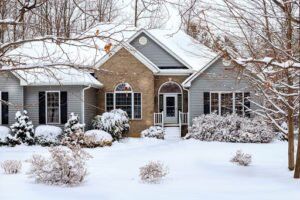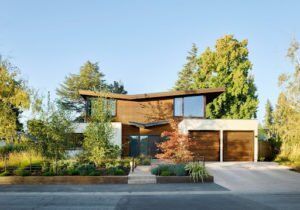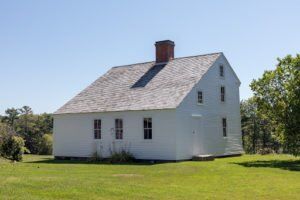8 Popular Residential Roofing Styles
Published on Monday November 13, 2017The right roof style can make or break your home. Whether your home has suffered from storm damage or your shingles are starting to curl, you’ll want to make sure that the residential roof style you choose for your roof replacement is an option that keeps the weather out, protects your family, seals off your home from pests — and looks great, too.
Common Roof Styles for Homes
Here are some of the most popular roofing styles you need to know about when considering a roof replacement:
Gable Roofs

One of the more traditional roofing options, gable roofs are made up of two slanted sides that meet at the highest point at a 90-degree angle to form a ridge. Though simple in its basic form, gable roofs across the world and throughout history have been adapted to fit many different homes and design styles, making them an extremely versatile roofing style.
The steep pitch (slope) of gable roofs are great for homes in cold and rainy climates because they insulate the home and shed rain and melted snow easily. This prevents moisture from causing water damage.
Hipped Roofs

Where gable roofs have two sides that meet to form a ridge, hipped roofs have four. A hipped roof is the most stable roof style because weight is evenly distributed around its base. Additionally, its shape is more resilient against high winds and heavy rains, making it a great option for people that live in areas where severe storms are common.
A popular subcategory is the cross hipped roof, which is made up of two intersecting hipped roofs that form an “L” or “T” shape.
The shallow angle of the pitch of hipped roofs also offers more attic headspace, which allows homeowners to convert the attic into livable space.
Flat Roofs

Contrary to the name, flat roofs are not entirely flat. They are pitched ever so slightly to allow water to drain. That being said, they are still not the best residential roof style if you live in a rain- or snow-heavy climate.
One of the best selling factors of flat roofs is their longevity. Flat roofs can often last up to 50 years, making them some of the longest lasting roofs on the market.
Since some HVAC components can be installed on the roof itself, it can save valuable square footage inside the home for those already living in cramped quarters.
Plus, many homes with flat roofs are designed so that the roof itself can be used as an extended outdoor living space, making them perfect for a rooftop deck, grilling space or a gathering area.
Shed Roofs

Consisting of a single plane that angles downward, shed roofs are common with homes where one wall is higher than another.
Though often used for utilitarian reasons, shed roofs can be designed to make quite the architectural statement, which is popular with modern or minimalist homes.
One of the great benefits of shed roofs is the amount of natural light they let in. Due to the very steep pitch, many homes with shed roofs are designed to have entire walls of windows or an extra layer of windows installed up high to let in light that more traditional roofs would otherwise block out.
Gambrel Roof

A gambrel roof, also known as a barn roof, is a two-sided, symmetrical roof with two slopes on each side: a steep, lower slope and a shallow, upper slope. Gambrel roofs often consist of wooden shingles and have a very traditional look and feel, harkening back to colonial America.
Similar to hipped roofs, the steep pitch of the lower slopes provide plenty of headspace, which allows homeowners with gambrel roofs to convert an attic or loft into livable space.
Unfortunately, gambrel roofs are not an ideal roofing style for homes located in areas prone to extreme weather conditions such as heavy rainfall as well as snow and winds. Reinforced trusses are recommended to help minimize the risk of weather-related damage.
Pyramid Roof

A pyramid roof, as the name suggests, is a type of hipped roof that resembles a pyramid. This roofing style consists of four, triangle-shaped slopes that form a single peak, built onto a square or rectangular frame. Pyramid roofs are a popular choice for sheds, gazebos and garages, or other small residential buildings like cabins and bungalows.
The biggest pro of a pyramid roof is its durability. Since weight is distributed evenly across the base of the roof, pyramid roofs are very stable, especially against strong winds. A con, however, would be the cost, as the complexity of the design requires skilled labor with specialized experience.
Butterfly Roof

A butterfly roof, also known as a V roof, is a modern roof design that consists of an inverted gable, which forms lifted “wings” that slope inwards and meet to form a valley. Butterfly roofs can be symmetrical or asymmetrical, which determines where the valley is located on the roof.
If you live in a warm, dry climate, butterfly roofs provide a unique advantage that can help you collect and store water during times of drought. Due to their inverted shape, butterfly roofs have no gutters. Rather, water flows down into the valley of the roof. Homeowners can take advantage of this water collection method by installing special infrastructure that allows this water to be stored in a holding tank for a variety of uses.
Even if you don’t live in a region where drought is common, a butterfly roof could be a good roofing style for your home. Since the “wings” are very aerodynamic and can resist wind damage, butterfly roofs are also common in coastal areas.
Saltbox Roof

Popular in New England, a saltbox roof is a gable roof with two asymmetrical planes: a shorter side with a low slope, and a longer side with a steep slope. These roofs are great for homes located in regions with heavy rainfall, as the steep slope sheds water easily to prevent moisture from penetrating the roof.
The biggest drawback to the saltbox roof style is that the longer side of the roof creates a slope indoors that cuts into living space, resulting in either low or angled ceilings.
Which Roofing Style is Best for Your Home?
Some roofing styles look and function better on certain homes in particular areas. A flat roof on a Washington, D.C. or Boston, MA row home is a classic look, but a house with a flat roof in Richmond’s Carytown? You may get some sideways glances.
Knowing the residential roof style you need for your home can help you plan your roof replacement much quicker and easier.
No Matter the Roofing Style, Long Has You Covered
With our SELECT ShingleMaster™ roof replacement accreditation, a distinction given to only one percent of roofers in the United States, the roofing experts at Long Roofing can tackle whatever roofing style fits your home.
Contact us online to request an in-home consultation and estimate to see what Long Roofing can do for your home.
Interested in Long Home Products?
See our special offers now.








